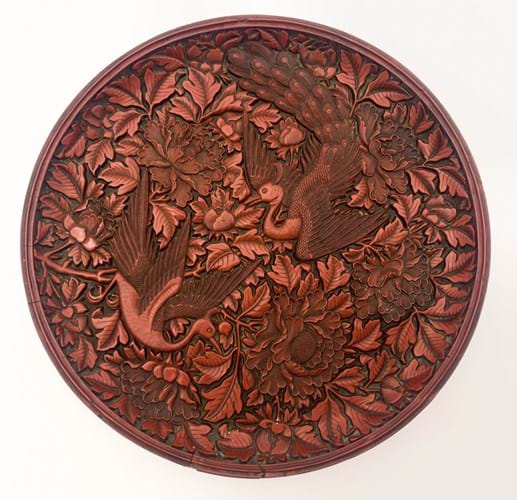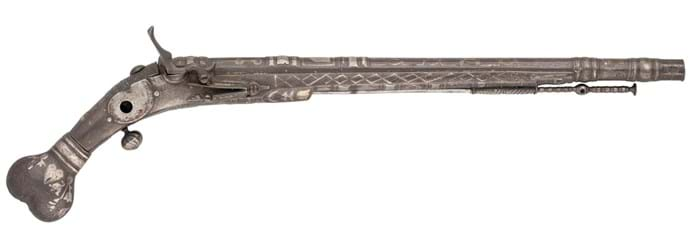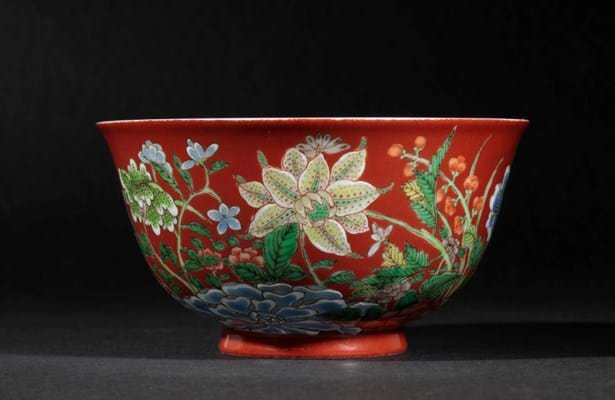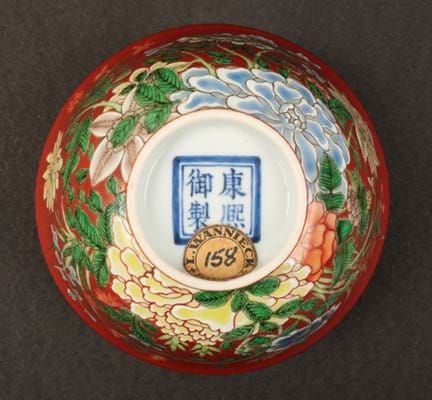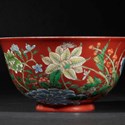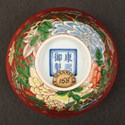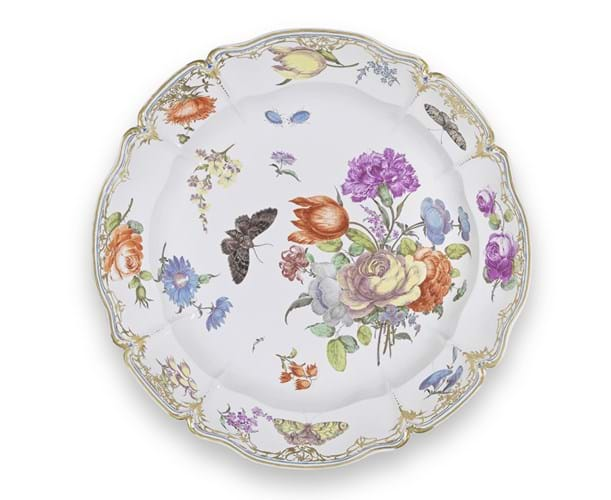1. 'Two-birds' dish – £165,000
The sale at Kinghams in Moreton-in-Marsh on December 10 included this 12in (30cm) carved cinnabar lacquer dish dating from the late Yuan or early Ming period – around 1350-1400.
The design is of two red-crowned cranes among peonies – a blessing for a long and wealthy life. Estimated at £2000-3000, it raced away to bring £165,000, selling to a London dealer against a phone bidder from mainland China. It is a house record for Asian art.
It is one of a distinct group of carved lacquer pieces known as 'two-birds' dishes. Although the species of birds and flowers vary from dish to dish, they share the same general composition. The choice of motifs on this dish is in keeping with a keen interest in Daoism and the attainment of immortality.
The unworked dark background is one typically associated with earlier carved lacquers. The design and execution were arguably better and more sophisticated than the similar late 14th century ‘phoenix and peony’ dish measuring almost 14in (35cm) across that sold for £90,000 at Bonhams in May.
At the time, the auction house said: ‘No other Yuan or early Ming red lacquer dish with this complex ‘phoenix and peony’ design – probably based on Southern Song dynasty prototype – is known’.
2. Scottish 17th century flintlock belt – £18,000
This 28-bore flintlock belt pistol is a type made in the east of Scotland in the late 17th century. Made entirely of steel with a 15in (37cm) multi-stage barrel, this example is decorated over its length in silver with engraved panels of flowers, foliage and scrollwork.
The inclusion of tulip flowers in the decoration is unusual and only recorded on a small number of pistols of this distinctive type. It has been suggested that this indicates a Protestant owner and approval of the succession of William of Orange.
At Olympia Auctions in London on December 7 it was sold to a member of the trade at £18,000 (estimate £7000-9000).
3. Painted Chinese bowl – £170,000
Duke’s sale in Dorchester on December 9 included a 4.25in (11cm) coral ground bowl painted with flowers in famille verte enamels that carried an underglaze blue Kangxi (1662-1722) yuzhi mark.
These special yuzhi reign marks ('made for imperial use of …') suggest a closer relationship to the imperial court and one of the few instances where the Jingdezhen potters received specific instructions as to the style of the underglaze-blue mark. They may have been enamelled in the imperial workshops in the Forbidden City of Beijing. Bowls of this type, thought to date from the end of Kangxi’s long reign, are held in important private and museum collections worldwide. This example, that was ‘acquired by the grandparents of the present owner and thence by descent’ had a fragmentary paper label for L Wannieck Paris, 158. Léon Wannieck was a Parisian Asian dealer in the first half of the 20th century.
Duke’s were unsure it was of the period but, estimated at £6000-8000, it took £170,000 – a sum closer to that achieved by Kangxi bowls of this type in Hong Kong.
4. Nymphenburg porcelain dish – £130,000
A new record for Nymphenburg porcelain was set at the 500 Years of European Ceramics sale at Bonhams on December 7.
A previously unrecorded pair of large circular dishes from the Hofservice c.1760-65 were part of a 20-lot tranche of 18th century European porcelain from the celebrated collection formed by the German-born, Argentine heiress Catalina von Pannwitz, née Roth (1876-1959). They multiplied the pre-sale estimate of £20,000-30,000 to sell for £130,000.
Catalina von Pannwitz, the second wife of the German lawyer and art collector Walter von Pannwitz (1858-1920), had sold their Berlin villa and moved to the Netherlands after he died. She displayed her magnificent collection of porcelain by leading German and French factories at De Hartekamp, a stately home in Heemstede.
These dishes, measuring 41cm and 42cm across, are from a service thought to have been made for the court of the Maximillian III, Joseph of Bavaria (1727-77). Both are superbly painted with a large flower spray and further scattered blooms, as well as butterflies, moths, beetles, a grasshopper and a caterpillar. The artist of these pieces is probably Joseph Zächenberger (1732-1802) whose signature is recorded on a Nymphenburg jar with this decoration. He worked at the factory as a flower painter from 1760-70 and is subsequently recorded as a mural and ceiling painter at the Tattenbach Palace in Munich.
A discussion of this lavish style of decoration is provided by Alfred Ziffer in his factory history Nymphenburger Porzellan Sammlung Bäuml (1997). Ziffer differentiates between the large, dark-toned flower bouquets, such as these, and other pieces painted with rather looser arrangements of flowers in a paler palette. It is possible that the latter represent a later delivery from the factory.
A pair of smaller 12in (30cm) oval dishes from the Hof service sold at a more modest £10,000 with a single 9in (27cm) plate selling at £5000.
5. Neolithic jade cong – £110,000
Neolithic jade congs – the inspiration for many pieces of Qing and later porcelain – are probably some of the most intriguing objects from ancient Chinese culture. They were carved by the Liangzhu people who lived around the current Lake Tai in Jiangsu province c.3300- 23OOBC.
Scholars are not sure of their actual purpose (they are dubbed ‘ritual objects’ by the international museums that own examples) although they have been found in the tombs of noblemen for use in the after-life.
The example offered by Alastair Gibson in London on December 14 measures just over 4in (11cm) high and is worked in a mottled green and brown stone with four tiers of mask decoration across its square outer and circular inner sections. It has a great provenance.
Once owned by Sir Ernest Debenham (1865-1952), the department store magnate who acquired it prior to 1928, it was later in the collection of Rolf, 2nd Baron Cunliffe of Headley (1899-1963). Over a period of almost 20 years from 1944 he bought more than 400 pieces from the famed London Chinese art dealership Bluett and Sons.
The cong was most recently acquired in the 1990s from a private collection in Chicago.
Such examples don’t come up for sale often although Alastair Gibson was able to point to two other four-tiered congs sold in the last three years in Hong Kong: one sold for HK$1.9m (£190,000) as part of the Chang Wei-Hwa collection of archaic jades (Christie’s, November 2019) and another for HK$500,000 (£48,000) from the Zan Ji Xuan collection (China Guardian, October 2022).
This third example, in good condition save some flaws to the corners, was estimated at £40,000-60,000 and did not disappoint, selling at £110,000.


